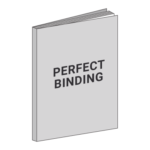Just like a cake, print pieces are not finished without the icing—and in this case, the icing comes in the form of binding and finishing options. With a huge variety of choices available, you’re sure to find the perfect finish for any type of print project. We’ve detailed the top choices that can make your next print project feel complete.
When print projects go beyond one printed sheet, they may need to be bound or fastened together to create a book, magazine, or booklet. Learn about our wide array of binding options to get an idea of which one may best fit your specific piece.

Saddle stitching is a style of binding typically used for booklets, magazines, catalogs, and calendars. Sheets of paper are stacked, folded in half, and then stapled through the fold line with wire staples. It’s one of the most popular binding methods for a variety of reasons. For starters, it’s the most cost-effective style of binding, but it also has a fast turnaround time, and is available in a wide range of sizes, and adds minimal bulk to your piece—which is a huge advantage for items that need to be shipped.
If you’ve ever read a hardcover book, you’ve seen an example of case binding! As one of the most classic (and classy!) ways to bind a book, case bindings are usually also the most time-consuming and expensive. However, because this style is so sturdy, it’s perfect for books that will be handled frequently and need to hold up over many years. This long-lasting binding option works with a minimum of 60 internal pages (or an amount that equals ⅛ inch), which get divided up into “signatures.” Signatures are small groupings of pages that are bound separately, collected and fastened together before being attached to the book’s cover.
If you’re looking for a cost-effective, lightweight option for high page count booklets, look no further than perfect binding. In fact, perfect binding is how most paperback books are bound and is the easiest way to produce books—making it an extremely popular choice. Unlike saddle stitching, a perfect bound book is created by gathering together the book’s pages and and gluing them along a heavier weight paper cover, thus creating a flat spine. Another perk of a perfect bound book is that they look like a professional hardcover case-bound book without the extra cost and production time.
A popular option with PostNet customers, comb binding is exactly what it sounds like—a round plastic comb inserted into the piece via holes in the spine. Comb binding is a cost-effective option to finish a book, calendar, or any project where you need to bind together laminated pages, which are thicker than normal paper. And thanks to the variety of comb sizes, comb bound books can be anywhere from four to 400 pages.
Wire-O binding (also known as twin loop, double-loop, double-O, duo-wire, or wire binding) uses pre-formed wire loops that run along in a C-shaped unit and are crimped to form a perfect circle. Commonly used for notebooks, wire-O binding is somewhat similar to comb, but as noted in the name, it uses wire instead of plastic to create a sophisticated appearance that many people prefer. This binding style also offers practical benefits—for example, wire-O bound pages can be opened a full 360 degrees, allowing all of the document’s pages to lie flat when opened, and it can be used on projects with a wide range of page counts.
Spiral binding is another style that appears similar to Wire-O and Comb bindings. Though this style also accommodates large page counts and allows pieces to lay flat when opened, the difference here is that Spiral binding uses a plastic coil that is one long piece with no gaps. To create this binding, the coil is inserted into the first hole along the edge of the grouped pages and wound through each one, resulting in a very durable, long-lasting binding.
Beyond the binding and fastening of sheets, PostNet offers many finishing options that give your project an added distinction. To put the final polish on your piece, consider adding one of these options.
A die cut lets you create a uniquely shaped piece or cut-out accent. Creating labels or adding a window on a book cover are great examples of when to use a die cut.
Embossing is a process that creates a raised image on book covers or other items. Debossing is the opposite—it creates a sunken image on a piece of paper.
The most common type of lamination is done by adhering a transparent material to a printed piece of paper to make it waterproof and sturdy. You’ll often see this finish used for menus. Another increasingly popular option is to choose a paper with a synthetic finish that acts like laminating.
Adding a foil provides an eye-catching detail to a book, magazine cover, or business card. Metallic foils are especially popular. They are applied using heat and can be combined with the embossing process.
Edge staining is when colors are applied to the page edges to mark different sections. This process is similar to gilding, where gold leaf is applied to the edges of the book.
Ready to take your print project to the next level?
Visit your nearest PostNet and talk to our experts about finding the best binding and finishing options for you.